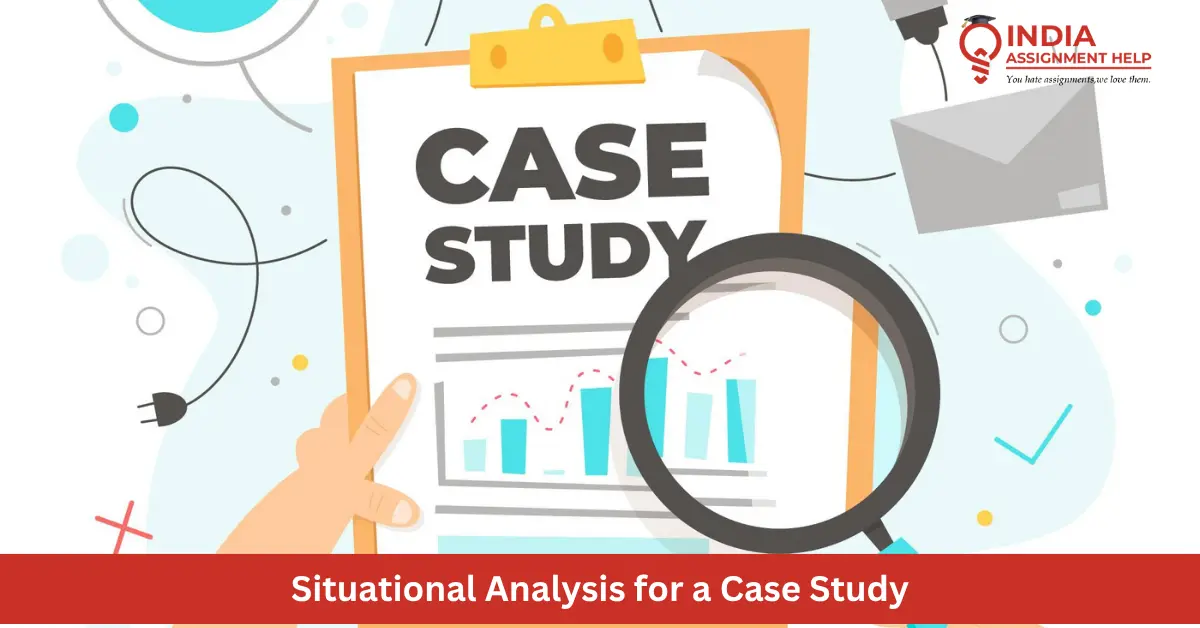How To Write a Situational Analysis for a Case Study

Have you ever wondered how businesses make informed decisions to stay ahead of their competition? The key lies in conducting a thorough Situational Analysis. Writing a situational analysis involves gathering and analyzing data to identify a company’s strengths, weaknesses, opportunities, and threats, setting a solid foundation for your case study or research.
It defines the context in which a company or problem exists, providing clarity for the entire analysis. Whether you're a student working on a case control study or a professional analyzing an organization, a well-written situational analysis guides your subsequent recommendations. But how do you actually write one? In this guide, we will explain what a situational analysis is and provide a step-by-step guide to creating an effective one.
What Is a Situational Analysis for a Case Study?
A situational analysis is a detailed examination of internal and external factors impacting an organization at a specific point in time. It helps readers understand the current position of the company before proposing a solution or strategies.
For Example, if you’re conducting a case study on Nike, a situational analysis would explore aspects such as current sales trends, market share, global competition (e.g., Adidas, Puma), and consumer preferences for sustainable footwear.
Why Is a Situational Analysis Important?
A situational analysis is essential because it:
- Builds context: Helps reader understand the background of the problem.
- Identifies root causes: Highlights internal weaknesses or external threats.
- Supports decision-making: Makes future strategies or recommendations more logical.
- Gives structure: Acts as a bridge between the introduction and the analysis or solution section.
When to Write a Situational Analysis
In a typical case study format, the situational analysis follows after the introduction but precedes the main discussion or proposed solution. It functions as a ‘status update’ on the business, industry, or subject being analyzing.
What to Include in a Situational Analysis
Your situational analysis can incorporate various elements depending on your case study type (marketing, strategy, HR, finance, etc.). But these six major components are fundamental:
1. Company Overview
Brief introduce the organization:
- What does the company do?
- When was it founded?
- Where is it based?
- What are its products/services?
Example:
Founded in 2010, Love Bonito is a Singaporean brand founded by three women. It has 27 stores across six Asian markets and caterers primarily to Asian women.
2. Current Market Situation
Examine the industry conditions and the company’s performance:
- Market trends (growing, declining, saturated?)
- Customer behavior and preferences
- Market size and growth
Example:
The rise of online shopping psot-COVID-19 provides Love, Bonito an opportunity to expand its digital presence and reach a broader audience.
3. Internal Environment (Strengths and Weaknesses)
Assess internal factors:
- Strengths: Strong brand, loyal customers, innovative product, talented team
- Weaknesses: Poor customer service, high costs, lack of innovation
Example:
Love Bonito benefits from a strong brand image among women, especially due to its focus on Asian women's body types and relatable social media marketing. However, it faces criticism for sustainability issues and fast fashion concern.
4. External Environment (Opportunities and Threats)
Analyze external factors:
- Opportunities: new markets, changing customer needs, technological advances
- Threats: economic downturns, increasing competition, regulatory changes
Example:
Growing internet penetration offer opportunities for expansion, but rising ethical concerns about fast fashion threatens profitability.
5. Competitor Analysis
Identify main competitors, and their positioning?
- What are their strengths?
- How are they different?
- What market share do they hold?
Example:
Love Bonito competes with brands like ASOS, forever 21, Pomelo fashion, which also target fashion-conscious women and hold a significant market share.
6. Customer Profile and Insights
Describe the target customer?
- Age, income, location, lifestyle
- Preferences and complaints
- Purchasing behavior
Example:
Primary customers are modern Asian women, from young professionals to working mothers who value style, quality, and convenience.
Frameworks to Use in Situational Analysis
To structure your analysis, consider frameworks like:
SWOT Analysis
- Strengths: internal positive factors
- Weaknesses: internal negative factors
- Opportunities: external positive factors
- Threats: external negative factors
Example (for Love Bonito):
- Strengths: Brand image, youth appeal
- Weaknesses: Sustainability concerns
- Opportunities: Launching eco-friendly lines
- Threats: Economic downturns affecting fashion sales
PESTLE Analysis
PESTLE Analysis helps you to analyze macro-environmental factors like
- Political: laws, regulations
- Economic: inflation, income levels
- Social: lifestyle trends, education
- Technological: automation, digital tools
- Legal: Licenses
- Environmental: waste, sustainability
Tips to Write a Strong Situational Analysis for a Case Study
- Use reliable data: Support claims with real data (even if hypothetical in student projects).
- Keep it balanced: Don’t just focus on problems; also mention what’s going well.
- Be concise but detailed: Avoid generic stuff, but don’t skip key insights.
- Avoid assumptions: Don’t assume success or failure; base it on analysis.
- Use visuals if possible: Tables, charts, and graphs improve clarity (optional for reports but helpful in presentations).
Common Mistakes to Avoid
Many students make these common errors:
- Overloading with background: Focus only on relevant information.
- Repetition: Don’t repeat points across sections.
- Vagueness: Explain why a factor is important.
- Ignoring competition: Remember, companies operate within a competitive environment.
- Lack of structure: Use frameworks like SWOT and PESTLE to organize your points.
Example Summary: Mini Situational Analysis for Coca-Cola
Let’s look at a very short example of situational analysis for a case study.
Company: Coca-Cola
Market Situation: Dominant player in the global soft drink market, facing declining in soda sales in health-conscious regions like the U.S.
Internal Factors: Strong brand, wide distribution network; weak in the health-oriented products.
External Factors: Rising health awareness, sugar taxes; opportunities in bottled water and low-calorie drinks.
Competitors: PepsiCo, local energy drink brands.
Customer Profile: Age 15–45, urban, brand-loyal but increasingly health-conscious.
Conclusion
A well-crafted situational analysis is the backbone of your case study. It connects the background to the problem, supports for recommendations, and demonstrates your critically thinking skills. Using structured frameworks and real examples will make your analysis more credible and persuasive.
Whether for academic purposes or real-world business analysis, mastering the art of writing a comprehensive situational analysis will serve you across industries.
We hope this guide has helped you understand how to write a, effective situational analysis for a case study. If you have any questions or need assistance with your case study, reach out to India Assignment Help, and we will be happy to support you.





